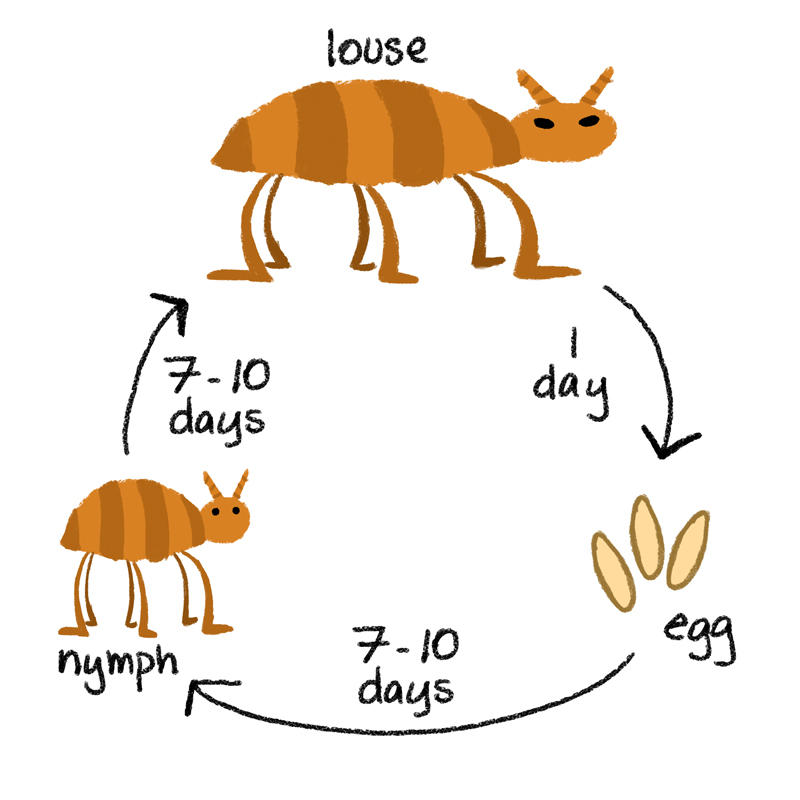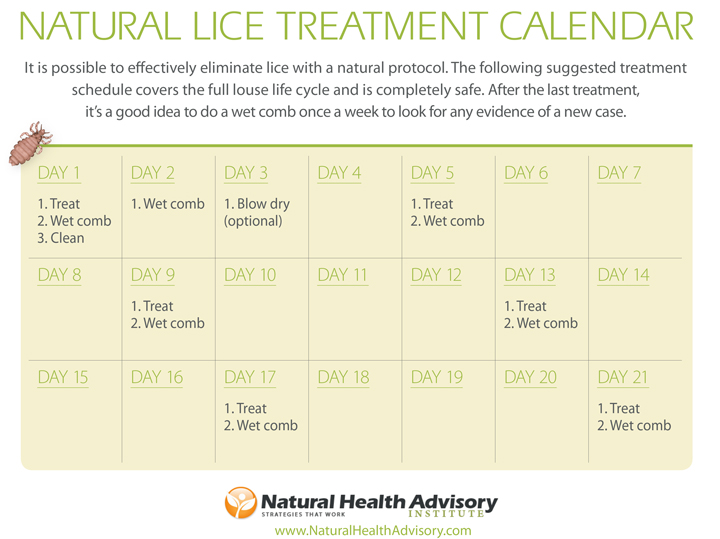Does Your Child Have Lice? Don’t Panic! Natural Lice Treatment Is Safe and Effective
Head lice are very contagious and can spread easily, causing countless missed days of work and school.
Head lice infest an estimated 6 to 12 million kids in the United States each year. Although they are not dangerous and do not spread disease, head lice are very contagious and can spread easily, causing countless missed days of work and school. Many parents are concerned about the toxicity of the pesticides in traditional lice treatment. These products aren’t even very effective now that lice have developed resistance to most products. Fortunately, research supports the use of natural lice treatment alternatives that are safe and non-toxic.
The Problem with Conventional Lice Treatments
A recent study reported that super-strains of lice found in at least 25 US states are resistant to most conventional treatments. The most widely used conventional treatments contain toxic pesticides such as malathion or permethrin. Despite the Centers for Disease Control’s assertion that these products are safe and effective when used as directed, some users have reported redness and burning of the scalp, headaches, nausea, vomiting, and dizziness.[5,6] Many products also contain warnings that they should not be used on people with asthma. Further, the potential long-term harmful effects of these insecticides, especially with repeated application, has not been researched.
Alternatives to Pesticides for Natural Lice Treatment
Fortunately, research indicates that several natural treatments are safe and effective options to treat head lice.[1-4] Many topical treatments contain various essential oils such as tea tree oil, eucalyptus, and lavender as active ingredients. These and other essential oils extracted from plants, including anise, peppermint, and citronella, are toxic to lice and their eggs.[7-9] Other natural ingredients, such as grapefruit seed extract and certain herbal extracts (especially Quassia Amara), are effective for treating head lice in clinical studies.[1-4,11]
These ingredients can be found in commercial shampoos and other solutions that are sold over-the-counter in pharmacies, health food stores, and some children’s salons. Brand names of some essential oil and herbal-based lice treatments that have been clinically tested and found to be effective include: MOOV Head Lice Shampoo by Ego and Quit Nits Complete Head Lice Kit by Wild Child The product line Nit Nanny is anecdotally reported to be effective as well.
The Wet Combing Method for Naturally Treating Head Lice
In addition to, or even in place of using a natural lice treatment, removing the lice and their eggs manually is a crucial part of the treatment process.[10] While it may be tedious and time-consuming, wet combing—carefully combing the hair with a lice comb—can absolutely be effective. Just remember that it needs to be done diligently and repeatedly to be effective. The term “nit-picking” really applies here. It only takes one missed nit to start a new outbreak.
Here’s exactly how to wet comb:
- Wash the hair using an ordinary shampoo.
- Apply ample conditioner to aid straightening and detangling. The conditioner can also slow down any live lice and make the nits more visible. Do not rinse out the conditioner until later in the process.
- Straighten and detangle the wet hair using a wide-toothed comb.
- Once the comb moves freely through the hair without dragging, switch to a head lice detection comb. These are very fine-toothed combs that you can buy in any pharmacy.
- Work in bright light, such as sunlight. You can also use a jeweler’s headlamp to illuminate and magnify the area you are working on.
- Make sure the teeth of the comb slot into the hair at the roots, with the deeply beveled edge lightly touching the scalp, and draw the comb down to the ends of the hair with every stroke.
- Check the comb for lice after each stroke and remove them by wiping or rinsing the comb. The lice are very small and look like small brown or white specks.
- Work through in small sections until the whole head has been combed through.
- If you see any nits that are not coming off with the comb, use your fingernail to scrape them off the hair.
- Rinse out the conditioner.
- Repeat the combing procedure in the wet hair to check for any lice that might have been missed the first time.
- Repeat the procedure regularly (every 2 to 3 days for at least 2 weeks) until no further lice are found.
While no treatment for head lice is always 100 percent effective (natural or not), keep your family safe by wet combing and choosing a pesticide-free, natural lice treatment the next time your little one comes home with lice.
Natural Lice Treatment Protocol
It is possible to effectively eliminate lice with a natural protocol. The followed suggested treatment schedule covers the full louse life cycle and is completely safe.
Understanding the Life Cycle

An egg will hatch in 7 to 10 days. That nymph will become an adult in 7 to 10 days. Within one day of adulthood, the louse will begin laying eggs.
The following scheduled is 21 days long to ensure that if any eggs do hatch, the nymphs will be killed before they lay their own eggs. It is imperative to complete the treatment protocol.
Day 1
Step 1: Treat.
Apply a non-toxic product to kill any live lice. One of our staff members swears by Nit Nanny, which requires repeated applications after 4 days. The following schedule is based on the Nit Nanny product.
Other natural options include MOOV Head Lice Shampoo by Ego and Quit Nits Complete Head Lice Kit by Wild Child. Fairy Tales, our staffer found, did not work.
Step 2: Wet comb.
Wet comb the hair using a nit comb. Find detailed instructions here.
Step 3: Clean
Wash all pillowcases, sheets, and any hats, toys or other smaller items in hot water (at least 140°F). Comforters, sofa pillows, stuffed animals and other items that heads have touched can go into the dryer on high heat for at least 30 minutes. Boil or replace all brushes, bows, clips or any other hair products. Vacuum sofas and the car. You can also kill lice on an object by putting it in the freezer for at least 10 hours, reports the CDC.
Day 2
Wet comb.
Day 3
Optional: Blow dry the hair.
A study found that a blow dryer can desiccate over 97% of any remaining eggs. (Am Fam Physician. 2007 Mar 15;75(6):910.) Divide dry hair into about 20 sections. Dry each section for 30 seconds, then flip the hair over and blow dry for another 30 seconds. (Each section will take one minute.)
Day 5
Step 1: Retreat
Step 2: Wet comb.
Day 9
Step 1: Retreat
Step 2: Wet comb.
Day 13
Step 1: Retreat
Step 2: Wet comb.
Remember that eggs hatch within 10 days, so if any eggs from day one survived, they would have all hatched by now. This treatment kills any of the nymphs that may have hatched before they can lay their own eggs.
Day 17
Step 1: Retreat
Step 2: Wet comb.
Day 21
Step 1: Retreat
Step 2: Wet comb.
Day 28 and once a week thereafter
It’s a good idea to do a wet comb once a week to look for any evidence of a new case.
Share Your Experience
If you’ve had a head lice outbreak in your family, how did you treat it? What worked? What was a waste of your time or money? Please share your experience with this very trying situation to help other readers, or post your questions below to get new ideas.
For related reading, please visit these posts:
This article was originally published in 2015. It is regularly updated.
[1] BMC Dermatol. 2010 Aug 20;10:6.
[2] Australas J Dermatol. 2012 Nov;53(4):255-63.
[3] Trop Biomed. 2013 Jun;30(2):315-24.
[4] Parasitol Res. 2010 Jan;106(2):445-9.
[5] Clin Evid (Online). 2011; 2011: 1703.
[6] CDC Website. Head Lice – Treatment. Accessed March 25, 2014.
[7] Arch Dermatol Res. 2007 Oct;299(8):389-92.
[8] J Med Entom 2004; 41(4):699-704.
[9] J Insect Sci. 2010; 10: 185.



 Safety of Silicone Bakeware?
Safety of Silicone Bakeware?  Personal Beliefs About Drugs Influence Brain Activity
Personal Beliefs About Drugs Influence Brain Activity  MGH Study: Hot Yoga May Help Ease Depression Symptoms, but Be Mindful of Health Concerns
MGH Study: Hot Yoga May Help Ease Depression Symptoms, but Be Mindful of Health Concerns 
Research supports the use of natural lice treatment alternatives that are safe and non-toxic.
© Niels Kliim | Dreamstime.com